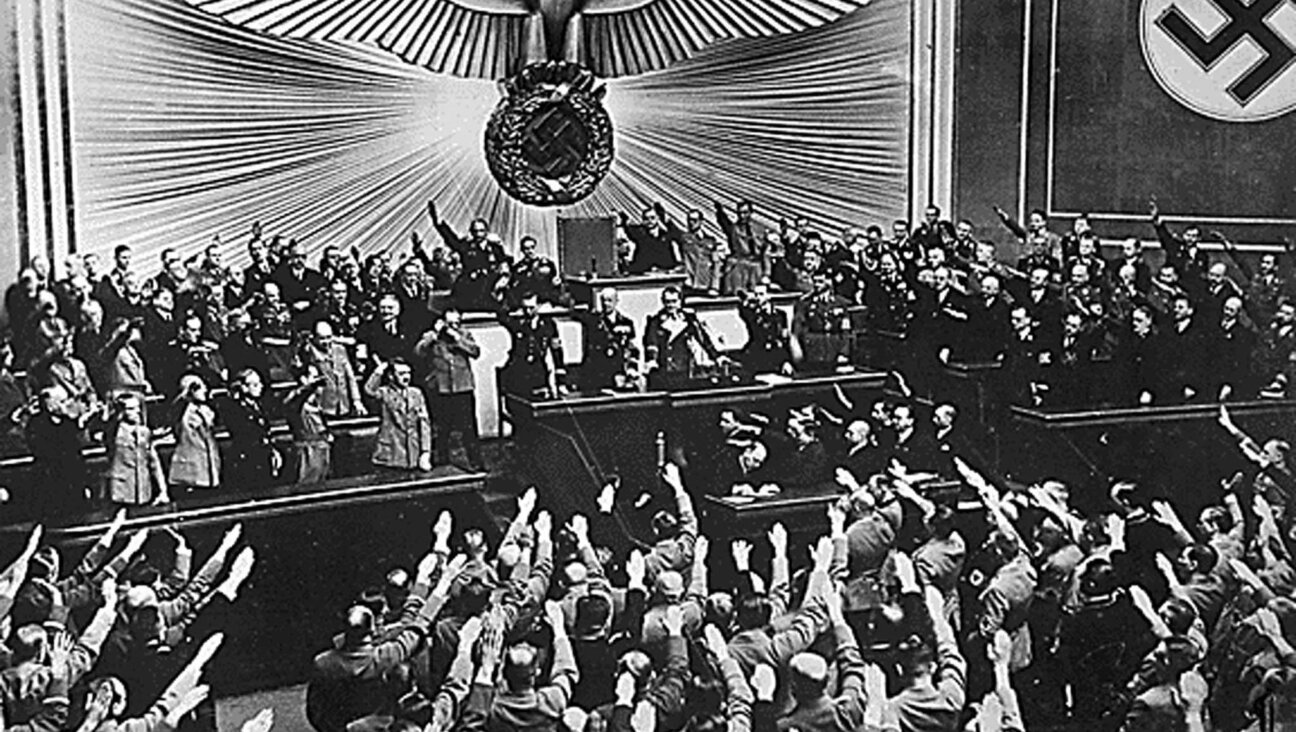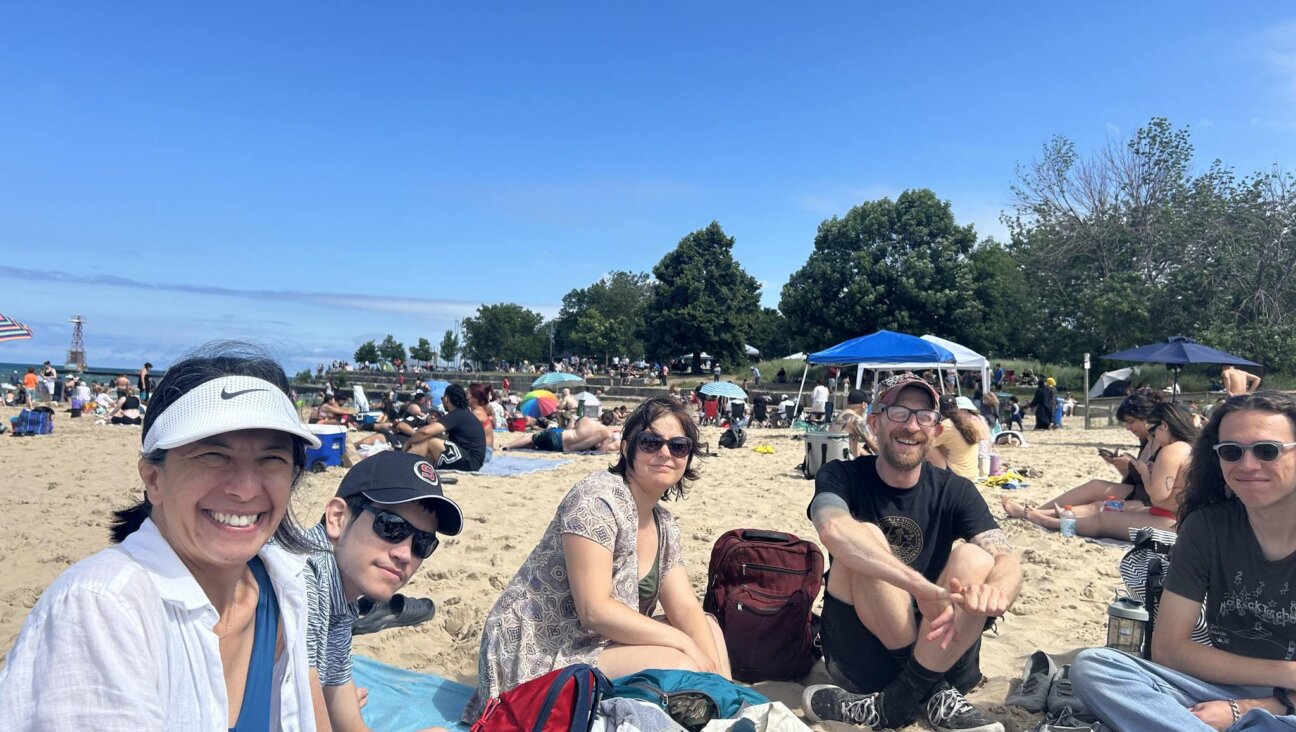What Yeshiva Kids Are Actually Studying All Day

Religious Jewish yeshiva (seminary) students pray in the synagogue at the Ponovezh Yeshiva, where they live and study for as many as nine years after high school, May 11, 2006 in the ultra-Orthodox city of Bnei Brak in central Israel. Image by Uriel Sinai/Getty Images
In the last few years, advocacy groups have criticized yeshivas (Orthodox private schools) in the New York area for offering students a substandard education.
YAFFED (Young Advocates for Fair Education) recently sued New York state, challenging the constitutionality of a recent amendment to an education law directed at these schools, and has argued that their education is not “substantially equivalent” to that in public schools. In the last few weeks, the State Education Department released their own guidance regarding ‘substantial equivalence’ that poses significant challenges to the current Yeshiva curricular structure.
This movement has placed intense public focus on the yeshiva system. Yet these schools’ aims and methods remain poorly understood—even by many of those calling for their reform.
While law and educational policy is not my field — ultra-Orthodox, or Haredi, education is. I have been researching and writing about ultra-Orthodox education for the past 15 years. And while I have no idea how the legal term “substantially equivalent” ought to be applied to yeshiva education — having studied the education in these schools for many years, I have no doubt that apart from the core secular studies they do learn, what these students learn every day in religious classes is educationally more than equivalent to what they would be otherwise studying in public school.
Amidst the current outcry over the yeshiva system, it is worth considering what students in a typical yeshiva are actually learning.
Long Days, Hard Work
What does the school day look like?
Girls in these communities receive substantially more secular education than boys and have not been the subject of recent criticism, so my focus here will be on boys’ schools. A yeshiva boy’s school day is very long—by middle school, often beginning at 7:30 A.M. with study and prayer services and ending only at 5:30 or 6:00 PM. In high school, boys continue to study until late at night, 9:30 PM or later.
Very little of this day, it’s true, resembles the secular curriculum found in traditional public schools, though these schools do find time for subjects such as English, math, social studies, and science. Having observed classes, from grades K – 12 in dozens of Haredi schools, I have watched students learn reading comprehension, spelling and handwriting; place value, multiplication and problem solving; early American history and global geography alike.
These subjects, however, do not constitute the central focus of the school day.
What are students doing the rest of the time?
The short answer is “religious studies”, but this is misleading — conjuring, perhaps, a vision of catechism memorization or ritual practice. Despite what many people believe, yeshiva students are not training to be pulpit rabbis—a fairly rare occupation in these communities.
Rather, yeshiva students’ “religious education” centers mainly on close textual study of a canon of ancient and medieval texts central to Jewish life: the Torah, the Talmud, and a near infinite body of commentaries on both.
In-class activities focused on these texts more closely resemble upper-level humanities coursework in a university than clerical training or contemplation of the Divine.
Enter a college course on any subject in the humanities, and you’ll likely find students working to parse the flow and meaning of primary texts, grappling with questions like “Who wrote this?”, “What were they trying to say?”, “Who was this written for?”, “What were they arguing against?”
This is not so different from what yeshiva kids spend most of their time doing—except that unlike most American university students, yeshiva kids are reading ancient and late ancient texts in their original languages (Biblical Hebrew, Mishnaic Hebrew, and Aramaic) rather than in translation.

A religious Jewish yeshiva (seminary) student studies in the Ponovezh Yeshiva May 11, 2006 in the ultra-Orthodox city of Bnei Brak. Image by Uriel Sinai/Getty Images
The Core Curriculum
Yeshivas offer additional subjects besides Torah and Talmud: classes in practical Jewish law, on the Prophets, on ethical instruction, and of course, core secular subjects (that deserve a column of their own). Extra-curricular subjects such as sports, music, or drama, are minimized, finding expression in more occasional school choirs (for Jewish holidays, for example), less structured (rather than organized) outdoor sports, and school plays, rather than a comprehensive drama curriculum. But above all, Torah and Talmud form the main part of the curriculum.
But there is more than meets the eye in Torah and Talmud. Each encompasses a wealth of knowledge and skills.
Torah (Bible)
Starting in pre-school, students spend time learning Hebrew letters and sounds alongside the kinds of classic Biblical stories that most people associate with religious instruction.

Ultra Orthodox children line up outside their kindergarten at Mea Shearim neighborhood in Jerusalem 31 May 2006 during celebration of the Jewish holiday of Shavuot. Image by MENAHEM KAHANA/AFP/Getty Images
But by very early into their elementary school experience—2nd or 3rd grade—this type of story-telling instruction fades away, and students instead begin reading the biblical text directly in Hebrew, learning eventually to analyze it using ancient and medieval commentaries. Detailed text-based questions like “Why is this word repeated?” “What was this character’s motivation?”, “Why does the text appear to stop mid-stream?” are typical. These classes offer students a top-notch education in close, critical reading and analysis.
These activities closely resemble the sorts of interventions that researchers have shown to be effective at developing reading comprehension. For example, one successful program developed in the 1980’s called reciprocal teaching asks students to read in small groups and to frequently pause to predict what will happen next, clarify what happened, or ask questions. Reciprocal teaching asks students to do a bare bones version of what yeshiva students do every day when studying biblical texts.
Talmud
By middle school, male students are studying Mishna and Gemara, which make up the Talmud, for the plurality of the day. (Girls don’t study Talmud, but continue to develop their skills in Hebrew Bible, studying the text closely, and analyzing its numerous commentaries). In Talmud class, students are asked to read, translate from Aramaic, and analyze complex, dense, and sophisticated legal arguments (originally codified between the 2nd and 5th centuries in present-day Israel and Iraq).
Much like the rest of the yeshiva school day, Talmud presents an unusual dichotomy; its study has profound religious meaning to members of these communities, but its substance is not always self-evidently “religious.” For example, students often begin Talmud study focusing on laws of damages, torts, and monetary law, and implicitly learn more about ancient Roman and Jewish law and life than any other group of eleven year olds in the world.
Very little of what students learn in Talmud class has direct bearing on contemporary religious practice—as noted, this is not rabbinical training, and current religious practice is substantially different from the simple reading of the Talmud text—rather, it is a complex academic endeavor that has profound religious significance as an act of study itself.

A student hangs up his hat and coat before lessons at the Ponovezh Yeshiva. Image by Uriel Sinai/Getty Images
This academic endeavor revolves around argumentation skills such as reasoning from evidence, resolving multiple perspectives, and contextualization among many others. Skills that fall under the rubric of argumentation are central to nearly every secular domain, and the Talmud text significantly develops these skills.
In Talmud study, students must follow extensive arguments, often presented in elaborate labyrinthine textual constructions. For example, the text might pursue an argument far into one direction just to see how far it will go, before reversing course and rejecting the premise altogether. Different versions of the same argument between two interlocutors might be presented, and the differences analyzed in light of the opinions of yet another pair of interlocutors. And the entire thread of the discussion may be interpreted very differently by later commentaries, further complicating things.
During a recent visit to one of the Hasidic schools in Brooklyn that Yaffed has criticized, I saw sixth-grade students parsing a complex argument in which two legal opinions drew on four different, but related, multi-step proofs, using subtleties in the biblical passages that served as proof-texts to make each argument. In a fifth-grade Talmud class in another one of the schools, the students had to determine how a biblical verse implicitly requires a charity obligation on a wheat field of 1/40th, 1/50th, or 1/60th of the field (which also entailed converting fractions such as 1.5/60 into 1/40).
When they parse these arguments, students must key in not only to the answers provided by the text, but also to the rationale of the questions themselves, in order to make sense of the underlying disputes. Talmud students quickly realize that if the question seems too obvious, they are likely missing the point.
Students are socialized into both the practices of Talmud study and the skills necessary to engage in those practices. For students in these yeshivas, Talmud instruction starts with the development of basic familiarity with the language (Aramaic), the ability to understand the legal arguments, and the approaches taken by Jewish legal authorities over time. As students progress into upper middle school and high school, they are expected to work on their own in pairs (called chavrusas) to decipher the text, make sense of the commentaries, and to generate their own arguments using evidence and logic. Students have a great deal of agency and autonomy over their learning, with lectures and other forms of teacher support fading away as they get older. By the time they are post high school, nearly all Talmud study is completely self-driven.

A yeshiva student uses his MP3 player to listen to Torah lessons at the Ponovezh Yeshiva. Image by Uriel Sinai/Getty Images
Are They Missing Too Much?
There are clear differences between a yeshiva education and a public school education. But how significant are these gaps? Are yeshiva students being denied a basic education? Does this educational program hamstring their ability to be constructive members of society?
I don’t think so.
There is much to be said about the aims and limits of the secular education offered by these schools. (I hope to address this question in a separate essay.) But there is an important sense in which their religious study alone provides a significant grounding in many of the essential skills that they would otherwise be receiving; enough, in fact to make the large curricular gaps somewhat beside the point.
This is something that, ironically, most members of the community itself don’t realize, as they take the strengths of this education for granted. But what these kids do in school is actually quite remarkable, and represents a level of intellectual achievement that is significant not only from a religious perspective, but also as a serious foundation for success in most domains beyond the religious community.
Pragmatically speaking, which best prepares students for future success—a secular school program, or a yeshiva program? Even given then schools’ acknowledged limits in secular instruction, I’d be hard pressed to pick the secular track. The critical thinking, textual analysis, reading comprehension, argumentation skills; the historical knowledge, the foreign language acquisition, the legal concepts; indeed, the Jewish culture, tradition, and ethical behavior (which are deeply important to all religious Jews, not just the ultra- Orthodox) embedded in these schools’ religious study are genuinely remarkable.
Talmud students are trained to appreciate that legal terms such as “substantially equivalent” bear specific technical meanings, are subject to a history of interpretation, and may be deployed differently within different social and historical frameworks.
It’s precisely their ability to understand this—when few students their age in any educational system can do the same—that ought to give critics pause before writing off these schools as less than “substantially equivalent” to public schools.
Moshe Krakowski is an Associate Professor at the Azrieli Graduate School for Jewish Education and Administration at Yeshiva University and directs Azrieli’s Master’s program in Jewish education. He studies American Charedi education and culture, curriculum, cognition, and inquiry learning in Jewish educational settings.
A message from our Publisher & CEO Rachel Fishman Feddersen

I hope you appreciated this article. Before you go, I’d like to ask you to please support the Forward’s award-winning, nonprofit journalism so that we can be prepared for whatever news 2025 brings.
At a time when other newsrooms are closing or cutting back, the Forward has removed its paywall and invested additional resources to report on the ground from Israel and around the U.S. on the impact of the war, rising antisemitism and polarized discourse.
Readers like you make it all possible. Support our work by becoming a Forward Member and connect with our journalism and your community.
— Rachel Fishman Feddersen, Publisher and CEO























